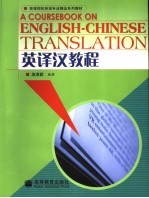

英译汉教程PDF电子书下载
- 电子书积分:13 积分如何计算积分?
- 作 者:连淑能编著
- 出 版 社:北京:高等教育出版社
- 出版年份:2006
- ISBN:7040189380
- 页数:367 页
Chapter 1 General Principles 1
1.1 What is Translation? 1
1.1.1 Linguistic Views on Translation 1
1.1.2 Cultural Views on Translation 1
1.1.3 Literary Views on Translation 2
1.1.4 Semantic Views on Translation 2
1.1.5 Functional Views on Translation 3
1.1.6 Communicative Views on Translation 3
1.2 The Assessment of Translation 3
1.2.1 Translation Criteria Put Forward by Famous Translators or Translation Theorists 3
1.2.2 Other Factors Affecting the Evaluation of Translation 6
1.2.3 Criteria for Beginners of Translation 7
1.2.4 Translation Proficiency:the Requirements of the Teaching Syllabus for the English Major(中国高等学校英语专业英语教学大纲对翻译教学的要求) 7
1.3 The Competence of a Translator 8
1.3.1 Excellent Command of the Two Languages 8
1.3.2 Considerable Knowledge of the Two Cultures 9
1.3.3 Adequate Knowledge of the Subject Matter 11
1.3.4 Fair Capacity for Writing 11
1.3.5 Plenty of Practice and Adequate Knowledge of Translation Theories and Skills 11
1.3.6 Skills in the Use of Information Technology 12
1.4 Translation Strategies 12
1.4.1 Literal Translation and Free Translation 12
1.4.2 Foreignizing Translation and Domesticating Translation 13
1.4.3 Style and Translation 15
1.5 Basic Processes in Translating 19
1.5.1 The Four-phase Process in Translating 19
1.5.2 Some Dos and Don'ts for Students 21
1.5.3 Procedures of Translation by a Team 21
Chapter 2 Contrastive Studies of English and Chinese 25
2.1 Studies of the English Language 25
2.1.1 External History:Historical Information Related to the English Language 25
2.1.2 Internal History:a Linguistic Review 28
2.1.3 Some Characteristics of English 29
2.2 Studies of the Chinese Language 31
2.2.1 Some Major Factors Affecting the Chinese Language 31
2.2.2 Some Characteristics of Modern Chinese 32
2.3 English vs.Chinese:Ten Pairs of Features 38
2.3.1 Synthetic vs.Analytic(综合语与分析语) 38
2.3.2 Rigid vs.Supple(刚性与柔性) 44
2.3.3 Hypotactic vs.Paratactic(形合与意合) 47
2.3.4 Complex vs.Simplex(繁复与简短) 49
2.3.5 Impersonal vs.Personal(物称与人称) 50
2.3.6 Passive vs.Active(被动与主动) 52
2.3.7 Static vs.Dynamic(静态与动态) 54
2.3.8 Abstract vs.Concrete(抽象与具体) 55
2.3.9 Indirect vs.Direct(间接与直接) 56
2.3.10 Substitutive vs.Repetitive(替换与重复) 59
Conclusion 66
3.1 Choice of Affective Meanings 67
Chapter 3 Diction(选词法) 67
3.2 Choice of Grammatical Meanings 70
3.3 Choice of Contextual Meanings 71
3.4 Choice of Collocative Meanings 72
3.5 Choice of Stylistic Meanings 74
3.6 Choice of Ambiguous Meanings 81
3.7 Choice of Extended Meanings 83
3.8 Choice of Equivalent Meanings 87
3.9 Choice of Exact Meanings 92
3.10 Choice of Different Chinese Words to Translate the Same English Word or Use of the Same Chinese Word(s)to Translate Different English Words 95
Conclusion 102
Chapter 4 Conversion(转换法) 103
4.1 Conversion of Word Classes 103
4.2 Conversion of Sentence Members 114
4.3 Conversion of Impersonal Subjects 118
4.4 Conversion of Perspectives 125
Conclusion 128
5.1 Structural Addition 129
Chapter 5 Addition(增补法) 129
5.2 Semantic Addition 130
5.3 Rhetorical Addition 140
Conclusion 144
Chapter 6 Omission(省略法) 146
6.1 Omission of Words Peculiar to English 146
6.2 Omission of Words Superfluous in Chinese 149
Conclusion 162
Chapter 7 Repetition(重复法) 164
7.1 Grammatical Repetition 165
7.2 Rhetorical Reduplication and Repetition 170
Conclusion 183
Chapter 8 Inversion(倒置法) 184
8.1 Inversion of Word Order in Translating Word-Groups or Phrases 184
8.2 Inversion of Word Order in Translating Attributes 185
8.3 Position of Adjective Clauses 188
8.4 Inversion of Adverbials 193
8.5 Position of Adverbial Clauses 194
8.6 Inversion of Sentence Structure 196
Conclusion 205
Chapter 9 Negation(反译法) 208
9.1 Transfer of the Negative 208
9.2 Conversion of the Affirmative into the Negative 211
9.3 Conversion of the Negative into the Affirmative 213
9.4 Translation of English Questions and Answers 216
9.5 Translation of Various Kinds of Negations 220
Conclusion 251
Chapter 10 Division(拆译法) 252
10.1 Picking Out of Words 252
10.2 Picking Out of Phrases 254
10.3 Splitting of Complex Sentences 256
10.4 Splitting of the Whole Sentence 262
Conclusion 268
11.1 Condensation of Phrases and Clauses 270
Chapter 11 Condensation(缩译法) 270
11.2 Condensation of Complex Sentences into Simple Sentences 271
11.3 Condensation of Compound Sentences into Simple Sentences 273
11.4 Condensation of Two or More Simple Sentences into One Simple Sentence 273
Conclusion 276
Chapter 12 Translation of the Passive(被动式译法) 277
12.1 Features of the English Passive 277
12.2 Features of the Chinese Passive 279
12.3 Common Ways to Translate the English Passive 282
Conclusion 289
Chapter 13 Translation of Long Sentences(长句译法) 290
13.1 Features of Long English Sentences 290
13.2 Features of Chinese Equivalents to Long English Sentences 291
13.3 Common Ways to Translate Long Sentences 292
Conclusion 311
Chapter 14 Translation of Culture-loaded Expressions(文化词语译法) 313
14.1 Foreignizing Translation 313
14.2 Domesticating Translation 317
14.3 Semantic Translation 320
14.4 Three Don'ts in Translating English Idioms 322
14.5 Proper Use of Chinese Idioms in Translation 330
Conclusion 343
Chapter 15 Translation of Proper Nouns and Technical Terms(专有名词和专门术语译法) 344
15.1 Transliteration 344
15.2 Semantic Translation 349
15.3 Both Transliteration and Semantic Translation 350
15.4 Shape-related Symbol Translation with a Semantic Explanation Added at the End 351
15.5 Semantic Translation with the Original Alphabet,Abbreviation or Number at the Beginning or at the End 351
15.6 Borrowing of the Original Abbreviation 351
15.7 Coinage of New Characters 352
Conclusion 357
Appendix Table on English-Chinese Transliteration(英汉译音表) 359
References 360
Further Reading 362
- 《高级英语阅读与听说教程》刘秀梅编著 2019
- 《看图自学吉他弹唱教程》陈飞编著 2019
- 《激光加工实训技能指导理实一体化教程 下》王秀军,徐永红主编;刘波,刘克生副主编 2017
- 《AutoCAD 2019 循序渐进教程》雷焕平,吴昌松,陈兴奎主编 2019
- 《少儿电子琴入门教程 双色图解版》灌木文化 2019
- 《Photoshop CC 2018基础教程》温培利,付华编著 2019
- 《剑桥国际英语写作教程 段落写作》(美)吉尔·辛格尔顿(Jill Shingleton)编著 2019
- 《英语自学进阶教程全6册 3》爱尔兰迪尔德丽出版社著 2019
- 《雅马哈管乐队训练教程 降E调单簧管 分谱》Japan Band Clinic委员会 2019
- 《线性代数简明教程》刘国庆,赵剑,石玮编著 2019
- 《市政工程基础》杨岚编著 2009
- 《家畜百宝 猪、牛、羊、鸡的综合利用》山西省商业厅组织技术处编著 1959
- 《《道德经》200句》崇贤书院编著 2018
- 《高级英语阅读与听说教程》刘秀梅编著 2019
- 《计算机网络与通信基础》谢雨飞,田启川编著 2019
- 《看图自学吉他弹唱教程》陈飞编著 2019
- 《法语词汇认知联想记忆法》刘莲编著 2020
- 《培智学校义务教育实验教科书教师教学用书 生活适应 二年级 上》人民教育出版社,课程教材研究所,特殊教育课程教材研究中心编著 2019
- 《国家社科基金项目申报规范 技巧与案例 第3版 2020》文传浩,夏宇编著 2019
- 《流体力学》张扬军,彭杰,诸葛伟林编著 2019
- 《全国高等中医药行业“十三五”创新教材 中医药学概论》翟华强 2019
- 《培智学校义务教育实验教科书教师教学用书 生活适应 二年级 上》人民教育出版社,课程教材研究所,特殊教育课程教材研究中心编著 2019
- 《指向核心素养 北京十一学校名师教学设计 英语 七年级 上 配人教版》周志英总主编 2019
- 《习近平总书记教育重要论述讲义》本书编写组 2020
- 《办好人民满意的教育 全国教育满意度调查报告》(中国)中国教育科学研究院 2019
- 《高等数学试题与详解》西安电子科技大学高等数学教学团队 2019
- 《北京生态环境保护》《北京环境保护丛书》编委会编著 2018
- 《教育学考研应试宝典》徐影主编 2019
- 《语文教育教学实践探索》陈德收 2018
- 《家庭音乐素养教育》刘畅 2018
